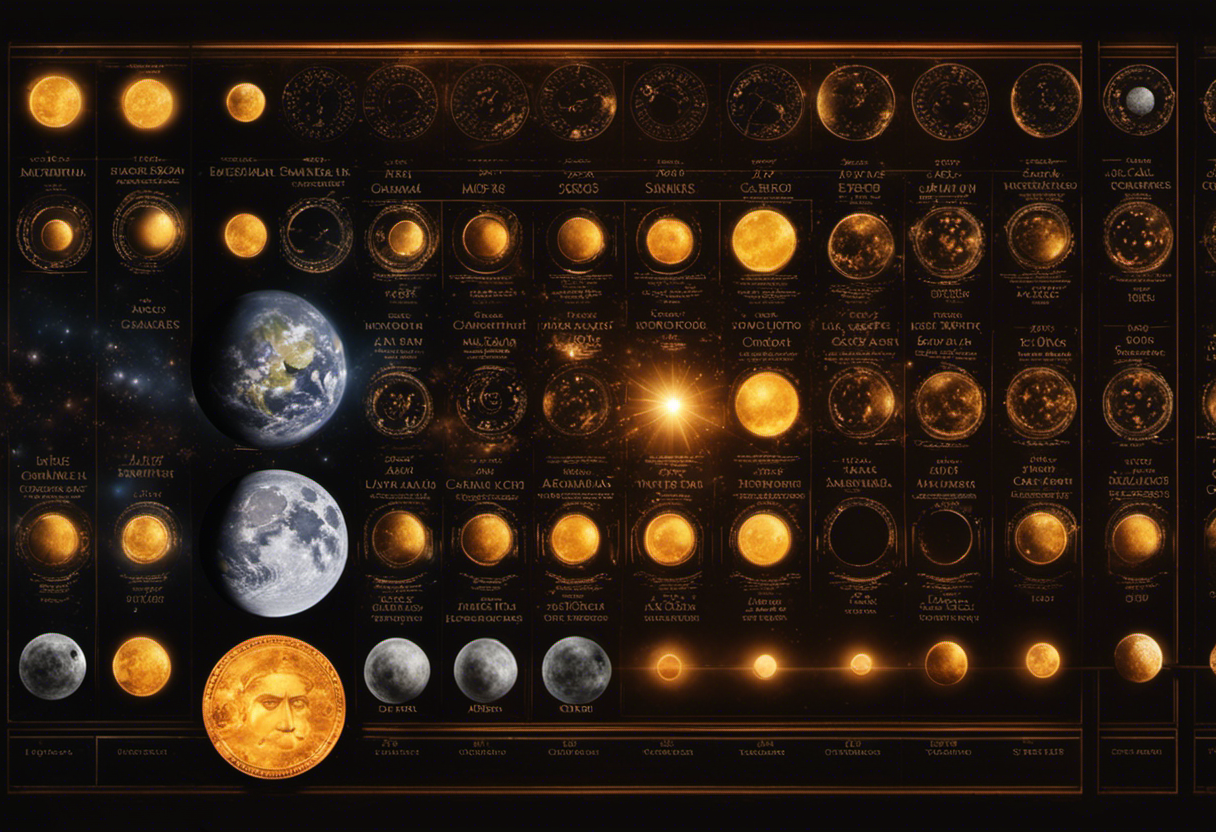In the realm of timekeeping, the Zoroastrian lunar calendar and the solar calendar stand as two distinct systems, each with its unique merits and drawbacks.
While the former is rooted in the ancient traditions of Zoroastrianism, the latter aligns with modern astronomical calculations.
This article delves into a comparative analysis of these calendars, exploring their historical backgrounds, key features, advantages, and limitations.
By examining the contrasts and similarities, we aim to shed light on the potential implications of adopting the solar calendar in Zoroastrianism.
Key Takeaways
- The Zoroastrian Lunar Calendar is shaped by cultural and religious significance, with the moon symbolizing purity and divinity in Zoroastrianism.
- The calendar is based on the cycles of the moon and is used for religious observances and festivals, integrating religious rituals based on moon phases.
- The advantages of the Zoroastrian Lunar Calendar include precise timing of religious events, cultural significance and connection to ancient heritage, and flexibility in adjusting dates based on moon sightings.
- However, the calendar has limitations such as inaccurate timing due to unpredictable moon sightings, varying lengths of lunar months causing inconsistencies, and difficulty in planning and participating in religious events.
Historical Background of the Zoroastrian Lunar Calendar


In order to fully understand the historical background of the Zoroastrian Lunar Calendar, it is crucial to delve into the cultural and religious significance that shaped its development. The Zoroastrian religion, founded by the prophet Zarathustra in ancient Persia around the 6th century BCE, played a significant role in the establishment of this lunar calendar. The historical origins of the calendar can be traced back to the religious practices and beliefs of the Zoroastrians, who considered the moon as a symbol of purity and divinity.
The Zoroastrian Lunar Calendar is based on the cycles of the moon, with each month beginning at the New Moon and lasting for approximately 29 or 30 days. This lunar calendar was used for religious observances, festivals, and rituals by the Zoroastrian community, and it continues to hold significance today. Despite the widespread use of the Gregorian calendar, the Zoroastrian Lunar Calendar is still followed by Zoroastrians for certain religious ceremonies and occasions.
The cultural and religious significance of the Zoroastrian Lunar Calendar lies in its connection to the natural world and the celestial bodies. It reflects the Zoroastrian belief in the harmony and balance of the universe, where the moon is seen as a symbol of purity and enlightenment. Today, the Zoroastrian Lunar Calendar serves as a reminder of the ancient traditions and spiritual beliefs of the Zoroastrian community, preserving their cultural heritage and religious practices.
Key Features of the Zoroastrian Lunar Calendar


The Zoroastrian Lunar Calendar distinguishes itself from other calendars by its unique system of measuring time based on the cycles of the moon, which allows for the precise calculation of religious observances and festivals. This calendar holds great historical significance and plays a crucial role in the practice of Zoroastrianism, an ancient religion that originated in ancient Persia.
Key Features of the Zoroastrian Lunar Calendar:
-
Lunar-Based System: The Zoroastrian Lunar Calendar follows a lunar-based system, where each month begins with the first sighting of the new moon. This lunar cycle is divided into 30 days, with an intercalary month occasionally added to align the lunar year with the solar year.
-
Precise Calculation of Festivals: The lunar-based system of the Zoroastrian Calendar allows for the accurate determination of religious observances and festivals. This precision ensures that important events, such as the celebration of the New Year (Nowruz) and the commemoration of religious figures, occur at the exact time they are supposed to.
-
Integration of Religious Rituals: The Zoroastrian Lunar Calendar integrates religious rituals into its framework. These rituals are based on the alignment of the moon and its phases, serving as a reminder of the importance of celestial bodies in Zoroastrian cosmology.
Advantages of the Zoroastrian Lunar Calendar


Utilizing the Zoroastrian Lunar Calendar allows for the precise timing and scheduling of religious events and festivals, enhancing the religious experience for practitioners by ensuring the accurate observance of important rituals.
The Zoroastrian Lunar Calendar is based on the cycles of the moon, with each month beginning at the sighting of the new moon. This calendar has several advantages over the solar calendar commonly used in many cultures.
One advantage of the Zoroastrian Lunar Calendar is its cultural significance. It is deeply rooted in the Zoroastrian faith and holds great importance for its followers. By following this calendar, practitioners are able to honor their religious traditions and maintain a connection to their ancient heritage.
Another advantage is the flexibility it offers in terms of scheduling religious events and festivals. The lunar calendar allows for the adjustment of dates based on the sighting of the new moon, ensuring that important rituals are observed at the appropriate time. This flexibility also allows for the accommodation of regional and cultural variations, as different communities may have different practices and customs.
Overall, the Zoroastrian Lunar Calendar provides a reliable and culturally significant framework for the timing and scheduling of religious events and festivals. Its advantages lie in its precision, flexibility, and ability to preserve the cultural heritage of the Zoroastrian community. By adhering to this calendar, practitioners are able to uphold their religious traditions and deepen their spiritual experience.
Limitations of the Zoroastrian Lunar Calendar


Despite its cultural significance and flexibility, the Zoroastrian Lunar Calendar faces limitations in accurately predicting the timing of religious events due to the unpredictable nature of moon sightings and the varying lengths of lunar months. While the calendar has been used for centuries and holds great importance in the Zoroastrian faith, it is not without its drawbacks.
-
Inaccurate timing: The Zoroastrian Lunar Calendar relies on the sighting of the moon to determine the beginning of a month. However, moon sightings can be affected by various factors such as weather conditions and the observer’s location. This makes it challenging to precisely determine the start of a month, leading to discrepancies in the timing of religious events.
-
Varying lunar months: Lunar months do not have a fixed duration like solar months. They can range from 29 to 30 days, causing further inconsistencies in the Zoroastrian Lunar Calendar. This can result in religious events being celebrated on different days each year, making it difficult for followers to plan and participate in these important occasions.
-
Lack of long-term accuracy: Due to the unpredictable nature of moon sightings and varying lunar months, the Zoroastrian Lunar Calendar lacks long-term accuracy. This means that over time, religious events may gradually shift away from their original dates, potentially causing confusion and disconnect from the traditions and practices associated with these events.
While the Zoroastrian Lunar Calendar holds cultural significance and flexibility, its limitations in accurately predicting the timing of religious events should be considered when planning and observing important occasions in the Zoroastrian faith.
Introduction to the Solar Calendar


The Solar Calendar is a timekeeping system that is based on the Earth’s orbit around the Sun. It originated in ancient civilizations that recognized the significance of the Sun in determining the seasons and agricultural cycles.
The Solar Calendar offers several benefits, such as providing a more accurate measurement of time and aligning with natural phenomena, which have contributed to its widespread adoption and cultural significance across different societies.
Origins of Solar Calendar
The Babylonians played a pivotal role in the development and establishment of the solar calendar, which has become the basis for the modern-day calendar system. The origins of the solar calendar can be traced back to ancient Mesopotamia, where the Babylonians observed the movements of the celestial bodies and developed a calendar based on the Earth’s orbit around the sun. This calendar, known as the Babylonian calendar, consisted of 12 months and was the first to introduce the concept of leap years.
The development of the solar calendar marked a significant milestone in human history, providing a standardized and systematic way to track time and organize various activities. It laid the foundation for future advancements in astronomy, mathematics, and navigation.
- The solar calendar brought about a sense of order and predictability in people’s lives, fostering a greater understanding of the natural world.
- It allowed for more accurate agricultural planning, helping civilizations optimize their farming practices and increase food production.
- The solar calendar had a profound cultural impact, influencing religious festivals, historical events, and societal customs.
Benefits of Solar Calendar
The benefits of the solar calendar are numerous and far-reaching, as it provides a more accurate and efficient way to track time and organize various activities.
One of the main advantages of a solar calendar is its precision in measuring the length of a year. By aligning with the Earth’s orbit around the sun, it ensures that each year is approximately 365 days long. This accuracy allows for better planning of agricultural activities, such as planting and harvesting, as well as for scheduling important cultural events and festivals.
Furthermore, the solar calendar holds cultural significance for many communities around the world. It often plays a crucial role in religious observances and acts as a unifying factor among different groups, fostering a sense of shared identity and tradition.
Overall, the solar calendar’s advantages and cultural significance make it a valuable tool for societies worldwide.
Cultural Significance of Solar Calendar
Significantly, the solar calendar’s cultural importance lies in its ability to serve as a shared framework for religious observances and cultural traditions, uniting communities worldwide.
The cultural impact of the solar calendar can be seen in various ways, with societal implications that shape the way people perceive time, celebrate festivals, and organize their daily lives. Here are three key aspects of the solar calendar’s cultural significance:
-
Religious Observances: Many religions, such as Christianity and Islam, follow solar-based calendars. This allows believers to synchronize their religious practices, ensuring that important events like Easter and Ramadan are celebrated at the same time each year.
-
Festivals and Celebrations: The solar calendar provides a fixed reference point for festivals and celebrations, allowing communities to plan and organize events well in advance. This fosters a sense of unity and anticipation, as people come together to commemorate cultural traditions and share joyful moments.
-
Seasonal Awareness: The solar calendar’s alignment with the changing seasons fosters a deep connection to the natural world. It enables societies to mark the cycles of agriculture, adapt to climatic shifts, and celebrate the beauty and abundance of each season.
The cultural impact of the solar calendar is profound, influencing how societies organize their time and celebrate their shared heritage. Its societal implications go beyond practicality, shaping the way people perceive and engage with the world around them.
Comparison of the Zoroastrian Lunar Calendar and the Solar Calendar


Comparing the Zoroastrian Lunar Calendar to the Solar Calendar reveals the distinct differences in their methods of timekeeping.
The Zoroastrian Lunar Calendar is based on the phases of the moon, and each month begins with the sighting of the new moon. This calendar consists of 12 months, with each month having either 29 or 30 days.
In contrast, the Gregorian Calendar, which is a solar calendar, is based on the Earth’s orbit around the sun and has a fixed number of days in each month.
The Zoroastrian Lunar Calendar has a significant impact on religious rituals and festivals. For example, the festival of Navroz, which marks the Zoroastrian New Year, is celebrated on the first day of the first month of the lunar calendar. Similarly, other religious events and ceremonies are also determined by the lunar calendar. The dates of these festivals and rituals can vary from year to year, depending on the sighting of the new moon.
On the other hand, the Gregorian Calendar provides stability and predictability in terms of dates. This allows for better planning and coordination of events and holidays. Its fixed dates ensure that religious festivals and rituals occur at the same time each year.
Pros and Cons of Adopting the Solar Calendar in Zoroastrianism


The adoption of the Solar Calendar in Zoroastrianism presents both pros and cons.
On one hand, switching to a solar-based calendar would align Zoroastrian religious festivals with the seasons, facilitating agricultural and cultural practices.
On the other hand, implementing a new calendar system would require significant adjustments, potentially disrupting traditional practices and causing confusion among the community.
Additionally, there might be resistance from those who value the historical and cultural significance of the lunar calendar.
Lunar Vs. Solar: Differences
A few key distinctions between the lunar and solar calendars emerge when evaluating the advantages and disadvantages of implementing the solar calendar within the Zoroastrian tradition.
-
Similarities:
- Both calendars are used to determine the timing of religious festivals and rituals.
- Both calendars are based on astronomical observations.
- Both calendars have a significant impact on religious practices, guiding the timing of important events and ceremonies.
-
Impact on Religious Practices:
- The lunar calendar, being based on the moon’s phases, results in a shorter year compared to the solar calendar. This leads to the need for intercalation, or the addition of extra months, to reconcile the two calendars.
- The solar calendar, being based on the Earth’s orbit around the sun, provides a more stable and predictable system for religious observations.
- The adoption of the solar calendar in the Zoroastrian tradition may lead to a more unified and standardized practice, simplifying the scheduling of religious events.
Benefits of Solar Calendar
One of the advantages of adopting the solar calendar in Zoroastrianism is the increased accuracy in determining the timing of religious festivals and rituals.
The Zoroastrian calendar traditionally followed a lunar system, which relied on the observation of the moon to determine the start of each month. However, this method often led to discrepancies and uncertainties in the timing of important events.
By transitioning to a solar calendar, Zoroastrians are able to align their religious festivals with specific dates in the solar year, ensuring a more precise and consistent celebration. This shift has great cultural significance as it allows for better planning and coordination among the community, promoting a stronger sense of unity and cohesion.
Additionally, the solar calendar enables Zoroastrians to synchronize their religious practices with the broader society, facilitating interfaith dialogue and understanding.
Challenges in Adoption?
Despite the potential benefits, some Zoroastrians may face challenges during the adoption of the solar calendar. The shift from the traditional lunar calendar to the solar calendar can be seen as a significant change that may disrupt established cultural practices and beliefs. Here are three key challenges in the implementation of the solar calendar:
-
Resistance from traditionalists: Some Zoroastrians may resist the adoption of the solar calendar due to its deviation from traditional practices and the fear of losing cultural identity.
-
Lack of widespread education: The successful adoption of the solar calendar requires educating the Zoroastrian community about its benefits and implications. This includes understanding the new system, adjusting religious practices, and updating religious festivals.
-
Cultural implications: The switch to the solar calendar can have wider cultural implications, affecting not only religious practices but also social and economic aspects of the community. It may require adjustments in various areas, such as work schedules, holiday planning, and community events.
Addressing these challenges will be crucial for a smooth and successful transition to the solar calendar within the Zoroastrian community.
Conclusion
In conclusion, the comparison between the Zoroastrian Lunar Calendar and the Solar Calendar reveals both advantages and limitations.
The Zoroastrian Lunar Calendar has a rich historical background and key features that are deeply rooted in Zoroastrian tradition. It has been used for centuries and has significant cultural and religious significance. The lunar cycle is closely tied to important festivals and rituals in Zoroastrianism, making it an integral part of the religious calendar.
However, the Zoroastrian Lunar Calendar also has limitations in terms of accuracy and synchronization with the solar cycle. Since the lunar cycle is approximately 29.5 days long, there is a discrepancy between the lunar months and the solar year. This can result in misalignments and variations in the timing of important events. Additionally, the lunar calendar does not account for leap years, which further affects its accuracy.
On the other hand, the Solar Calendar offers a more precise and globally recognized system. It is based on the Earth’s orbit around the Sun and is widely used in many cultures and religions around the world. The solar year is approximately 365.25 days long, and adjustments like leap years ensure that the calendar stays synchronized with the astronomical cycle.
Ultimately, the decision of adopting the Solar Calendar in Zoroastrianism should be carefully considered, weighing the pros and cons for the community. While the Solar Calendar offers accuracy and global recognition, it may also require significant adjustments to the religious practices and traditions associated with the lunar calendar. The community should take into account the historical and cultural significance of the Zoroastrian Lunar Calendar before making a decision.



